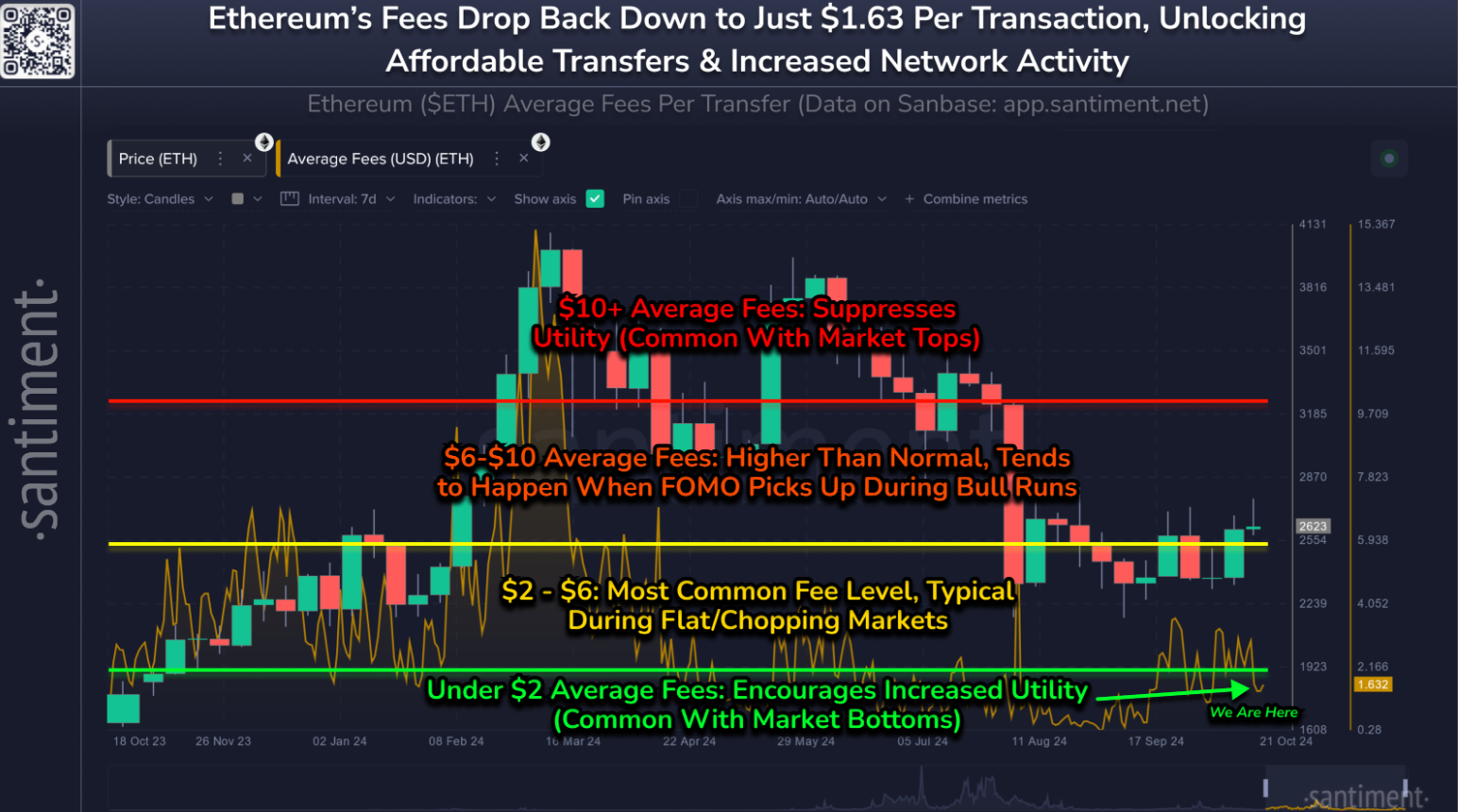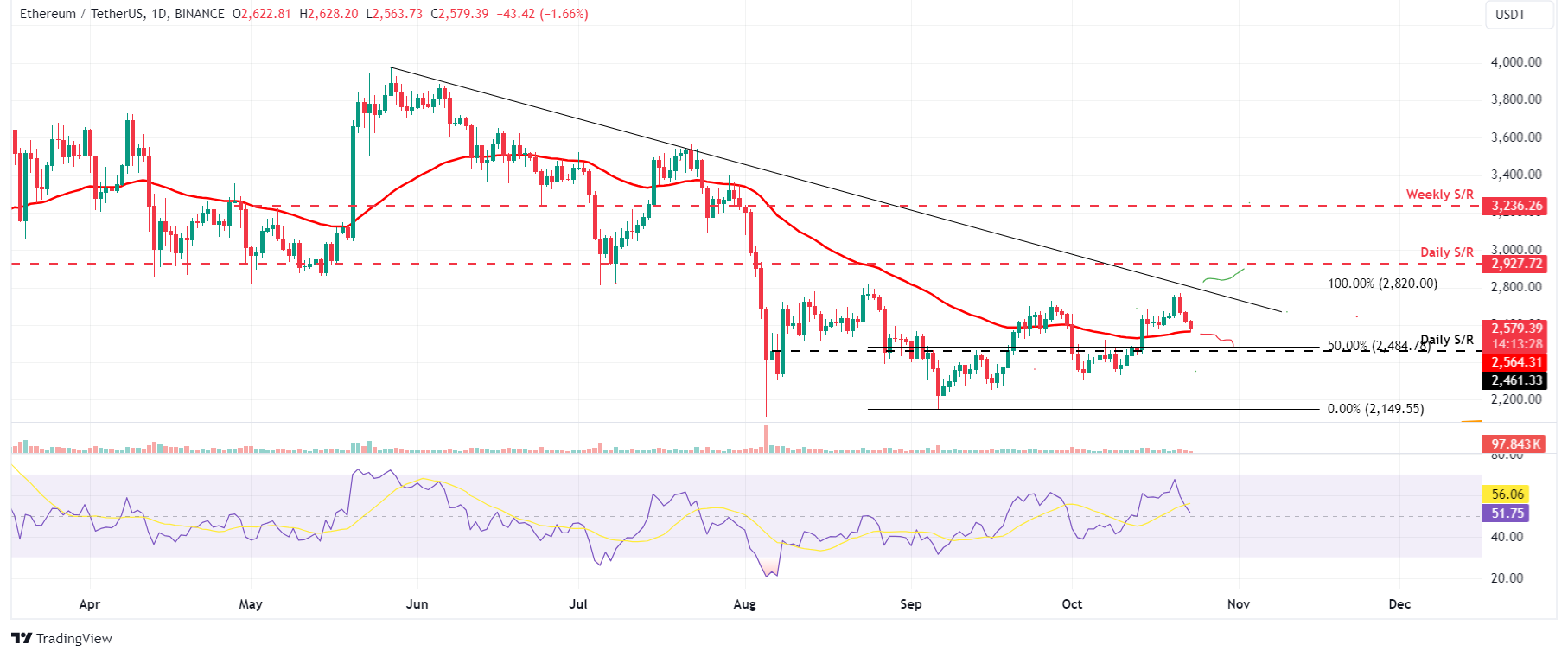Ethereum Price Forecast: Lower average fees may increase ETH network usage
Ethereum price today: $2,580
- Ethereum continues to trade down for the third consecutive day following rejection from the $2,700 level.
- ETH average fees drop below $2, boosting the prospects for increased network usage.
- Coinbase Premium Index data shows weakness and remains below neutral levels of zero.
Ethereum (ETH) price continues to trade in the red for the third consecutive day on Wednesday after being rejected at the $2,700 level on Monday. Though the average fees dropping below $2 may boost network usage, traders should remain cautious as Coinbase Premium Index data indicates weak institutional demand.
Ethereum fees fall below $2, boosting prospects for increased network usage
Santiment’s data shows that Ethereum's average fees reach $1.63 on Tuesday, an affordable level that historically has encouraged traders to increase their transfer frequency.
Historical data shows that when the ETH average fee drops below $2, the utility and usage of the ETH network increase, which could lead to a rally in Ethereum's price. Moreover, as stated in the previous article, the chances of a short squeeze could also drive ETH higher.

Ethereum’s Average Fee chart. Source: Santiment
CryptoQuant’s Ethereum Coinbase Premium Index shows signs of weakness and remains below neutral levels. This indicator measures the price gap between Coinbase Pro (USD pair) and Binance (USDT pair), and it serves as a key metric for assessing the behavior of large-wallet investors as it reflects whale accumulation trends. This is significant because Coinbase Pro is a primary gateway for institutional cryptocurrency purchases.
In the case of Ethereum, the metric currently stands at -0.075, below its neutral level of zero. It has been constantly declining since early October. If this downward trend persists or increases, it could increase selling pressure for Ethereum.
-638652771504314464.png)
Ethereum Coinbase Premium Index chart. Source: CryptoQuant
Ethereum Price Forecast: Retesting 50-day EMA
Ethereum faced resistance around its descending trendline (drawn by joining multiple highs from the end of May) on Monday and declined 4.5% until Tuesday. As of Wednesday, it continues its decline, retesting its 50-day Exponential Moving Average (EMA) at $2,564.
If ETH breaks and closes below the 50-day EMA, it could decline further to retest its daily support level of around $2,461.
The Relative Strength Index (RSI) indicator trades at 51 and points downwards on the daily chart after rejection around its overbought level of 70 on Sunday. This indicates a weakness in bullish momentum. If RSI continues to decline and closes below its neutral level of 50, it could lead to a sharp decline in Ethereum price.

ETH/USDT daily chart
However, if ETH finds support around the 50-day EMA at $2,564 and closes above $2,820 (the August 24 high), Ethereum’s price could rally to retest its next daily resistance at $2,927.
Ethereum FAQs
Ethereum is a decentralized open-source blockchain with smart contracts functionality. Its native currency Ether (ETH), is the second-largest cryptocurrency and number one altcoin by market capitalization. The Ethereum network is tailored for building crypto solutions like decentralized finance (DeFi), GameFi, non-fungible tokens (NFTs), decentralized autonomous organizations (DAOs), etc.
Ethereum is a public decentralized blockchain technology, where developers can build and deploy applications that function without the need for a central authority. To make this easier, the network leverages the Solidity programming language and Ethereum virtual machine which helps developers create and launch applications with smart contract functionality.
Smart contracts are publicly verifiable codes that automates agreements between two or more parties. Basically, these codes self-execute encoded actions when predetermined conditions are met.
Staking is a process of earning yield on your idle crypto assets by locking them in a crypto protocol for a specified duration as a means of contributing to its security. Ethereum transitioned from a Proof-of-Work (PoW) to a Proof-of-Stake (PoS) consensus mechanism on September 15, 2022, in an event christened “The Merge.” The Merge was a key part of Ethereum's roadmap to achieve high-level scalability, decentralization and security while remaining sustainable. Unlike PoW, which requires the use of expensive hardware, PoS reduces the barrier of entry for validators by leveraging the use of crypto tokens as the core foundation of its consensus process.
Gas is the unit for measuring transaction fees that users pay for conducting transactions on Ethereum. During periods of network congestion, gas can be extremely high, causing validators to prioritize transactions based on their fees.

